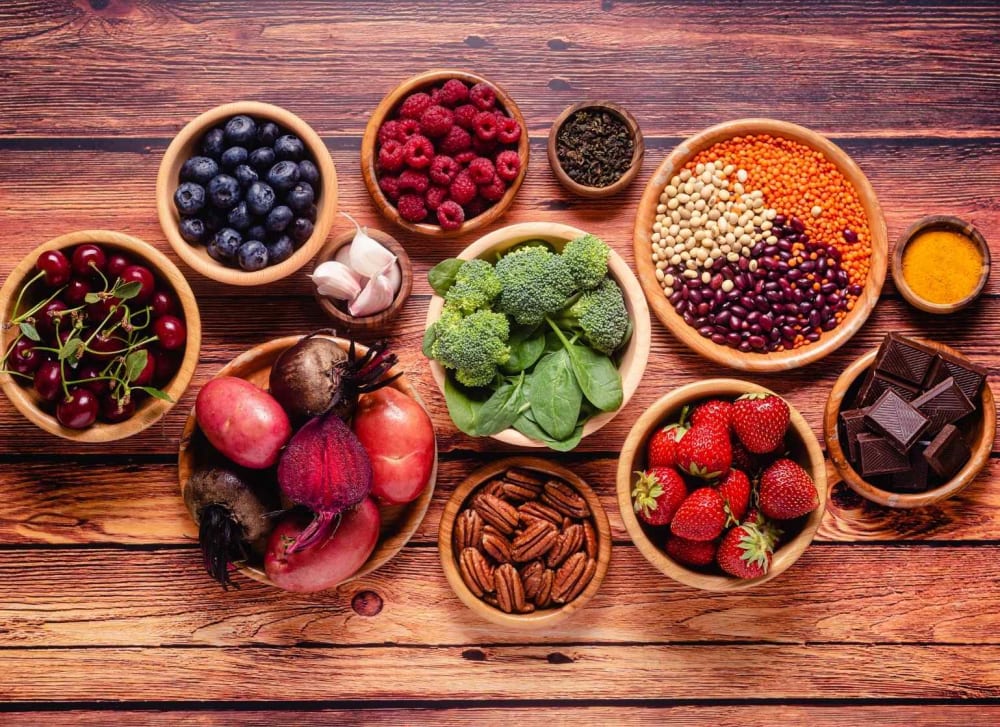
A diet rich in fruits and vegetables can help reduce inflammation. Aim to eat nine of these fruits and vegetables each day. Fresh fruit should be consumed, especially if it is high in antioxidants like strawberries. Whole grains are important, but rice noodles should be limited to only a few times per week. Avoid baking flour, as this does not constitute an anti-inflammatory diet. These foods can help you feel more active and prevent inflammation.
A diet high in green leafy vegetables is a good choice to promote good health. This will increase your intake of omega-3 fat acids and reduce inflammation. You can also opt for organic meats and dairy products. Also, consider omega flax oil and fish oil for dietary fats. Last but not least, olive or sesame ole are good for you. They also contain high levels of vitamin E.
Another way to reduce inflammation is to eat whole foods. Try to eat foods with no added sugar. Vegetables are the best option. You can eat low-fat dairy products, fruits and vegetables, nuts, seeds and olive oil for a healthy lifestyle. Herbs and spices can also be useful for adding flavor to your food. The addition of antioxidants and vitamin E to your dishes can help reduce free radicals.

There is no cure for inflammation. However, there are things you can do to lower your chances of developing it. You should eat lots of fresh fruits and vegetables and avoid sugary and processed foods. Also, it is important to include some coconut oil and fatty seafood in your diet. These foods are good for you and will reduce inflammation. EverlyWell offers a vitamin D and high-sensitivity CRP test kit that will help you include more anti-inflammatory foods into your diet.
While there are no studies that support this claim, there is ample evidence to suggest that in many cases, reducing inflammation can be a good idea. It can help to prevent chronic diseases like heart disease and cancer. Inflammation is an inherent part of our bodies. It is a normal, healthy reaction that protects us from injury. Inflammation can be reduced by changing your diet. You can lower your risk of developing chronic diseases by following these guidelines.
Your health is directly affected by the foods you eat. For example, onions are rich in quercetin, a substance that inhibits the production of histamines. Berry products contain anthocyanins, which moderate inflammation. This is not an anti-inflammatory diet. However, it can be a good option to include foods rich in flavones or other anti-inflammatory substances. Include whole grains, berries and fruits in your diet.
The inflammatory process has several causes. Chronic inflammation can be caused by obesity, pollution, poor sleep, and excessive weight. A balanced diet, rich in water and high-quality anti-inflammatory food will reduce the risk of chronic inflammation. It is essential to eat a healthy diet in order to keep your body balanced. Include anti-inflammatory food in your diet to keep your body in a normal state.

Inflammation can happen in many parts of your body. Inflammation can cause chronic pain, ear infections and even cancer if your body isn't used to it. Eat foods rich in polyphenols such as blueberries or leafy greens to reduce inflammation. These compounds are also found in coffee which may protect your body from inflammation. It is possible to improve your diet and get enough sleep.
Chronic inflammation is directly related to your diet. Many people are suffering from chronic health problems because of their diets. Although inflammation is a natural response to injury, it can also cause many health problems. Inflammation can be caused by consuming a lot of refined carbohydrates. Sugary drinks, for example, can be detrimental to your health. They can cause pain in the joints, fatigue, and other symptoms. They can also promote the development of cancer and cardiovascular diseases.
FAQ
How can you tell what is good?
You need to listen to your body. Your body is the best judge of how much exercise, food and rest you should get. It's important to pay attention to your body so you don't overdo things. Listen to your body and make sure you're doing everything you can to stay healthy.
What is the difference of fat and sugar?
Fat is an important energy source, which comes from food. Sugar is a sweet substance that can be found naturally in fruits or vegetables. Both fats as well as sugars contain the same amount of calories. However, fats contain more than twice as many calories as sugars.
Fats are stored within the body and can contribute to obesity. They cause cholesterol buildup in arteries which may lead to heart attacks and strokes.
Sugars provide instant energy and are rapidly absorbed by the body. This causes blood glucose levels in the body to rise. High blood sugar levels can cause type II diabetes.
How can I control my blood pressure?
You must first determine the cause of high blood pressure. Then you need to take steps to reduce this cause. These could include taking medication, eating less salt and losing weight.
Also, make sure to get enough exercise. Walking is a great alternative if you don't have the time or energy to exercise regularly.
If you're not happy with how much exercise you're doing, then you should consider joining a gym. You'll probably want to join a gym where there are other people who share your goals. You will find it easier to keep to a workout schedule if you have someone to watch you at the gym.
How does an anti-biotic work?
Antibiotics are drugs that destroy harmful bacteria. Antibiotics are used for treating bacterial infections. There are many types of antibiotics. Some are given orally, while some are injected. Other antibiotics are applied topically.
People who have been exposed may be prescribed antibiotics. For example, if someone has had chicken pox, he or she might take an oral antibiotic to prevent shingles later on. A penicillin injection might be given to prevent pneumonia in someone who has had strep.
Doctors should prescribe antibiotics to children. Children are at greater risk of developing side effects from antibiotics than adults.
The most common side effect of antibiotics is diarrhea. Other possible side effects include stomach cramps, nausea, vomiting, allergic reactions, headaches, dizziness, and rashes. Most of these symptoms disappear after the treatment is completed.
Statistics
- According to the 2020 Dietary Guidelines for Americans, a balanced diet high in fruits and vegetables, lean protein, low-fat dairy and whole grains is needed for optimal energy. (mayoclinichealthsystem.org)
- nutrients.[17]X Research sourceWhole grains to try include: 100% whole wheat pasta and bread, brown rice, whole grain oats, farro, millet, quinoa, and barley. (wikihow.com)
- In both adults and children, the intake of free sugars should be reduced to less than 10% of total energy intake. (who.int)
- Extra virgin olive oil may benefit heart health, as people who consume it have a lower risk for dying from heart attacks and strokes according to some evidence (57Trusted Source (healthline.com)
External Links
How To
What does "vitamin" actually mean?
Vitamins are organic substances found naturally in food. Vitamins help us absorb nutrients from foods we eat. Vitamins are not made by the body, so they must be obtained through food.
There are two types: water-soluble and fat-soluble vitamins. Water-soluble vitamins dissolve readily in water. These include vitamin C (thiamine), Vitamin B1 (riboflavin), Vitamin B2 (riboflavin), Vitamin B3 (niacin), Vitamin B6 (pyridoxine), Vitamin C, B1 (thiamine), Vitamin B2 (riboflavin), Vitamin B3 (niacin), and Vitamin B6 (pyridoxine). Fat soluble vitamins are stored in the liver and fatty tissue. Examples include vitamin D, E, K, A, and beta carotene.
Vitamins can be classified by their biological activity. There are eight major vitamin groups:
-
A – Essential for normal growth, and the maintenance of good health.
-
C - vital for proper nerve function, and energy production.
-
D - essential for healthy bones, teeth, and gums.
-
E is required for good vision and reproduction.
-
K - essential for healthy muscles, nerves, and bones.
-
P - Essential for strong bones and teeth.
-
Q - aids digestion and absorption of iron.
-
R - Required for red blood cell production
The recommended daily allowance (RDA) of vitamins varies depending on age, gender, and physical condition. The U.S. Food and Drug Administration, (FDA), sets the RDA value.
For example, the RDA for vitamin A is 400 micrograms per dayfor adults 19 years or older. For fetal development, pregnant women need 600 mg per day. Children ages 1-8 require 900 micrograms per day. Infants under one year of age require 700 micrograms per day, but this amount decreases to 500 micrograms per day between 9 months and 12 months of age.
Children aged between 1-18 years require 800 micrograms of sugar per day, while overweight children need 1000 micrograms. Children who are underweight receive 1200 micrograms every day to meet their nutritional requirements.
Children aged 4-8 years old who have been diagnosed as having anemia require 2200 micrograms of vitamin C per day.
2000 micrograms are required daily for good health in adults over 50. Mothers who are pregnant, nursing, or have a high nutrient need will require 3000 micrograms a day.
1500 micrograms are required daily by adults over 70 because they lose approximately 10% of their muscle each decade.
Women who are pregnant or lactating need more than the RDA. Pregnant and breastfeeding women require 4000 micrograms each day during pregnancy and 2500 Micrograms each day after delivery. Breastfeeding mothers need to consume 5000 micrograms every day when breastmilk has been produced.